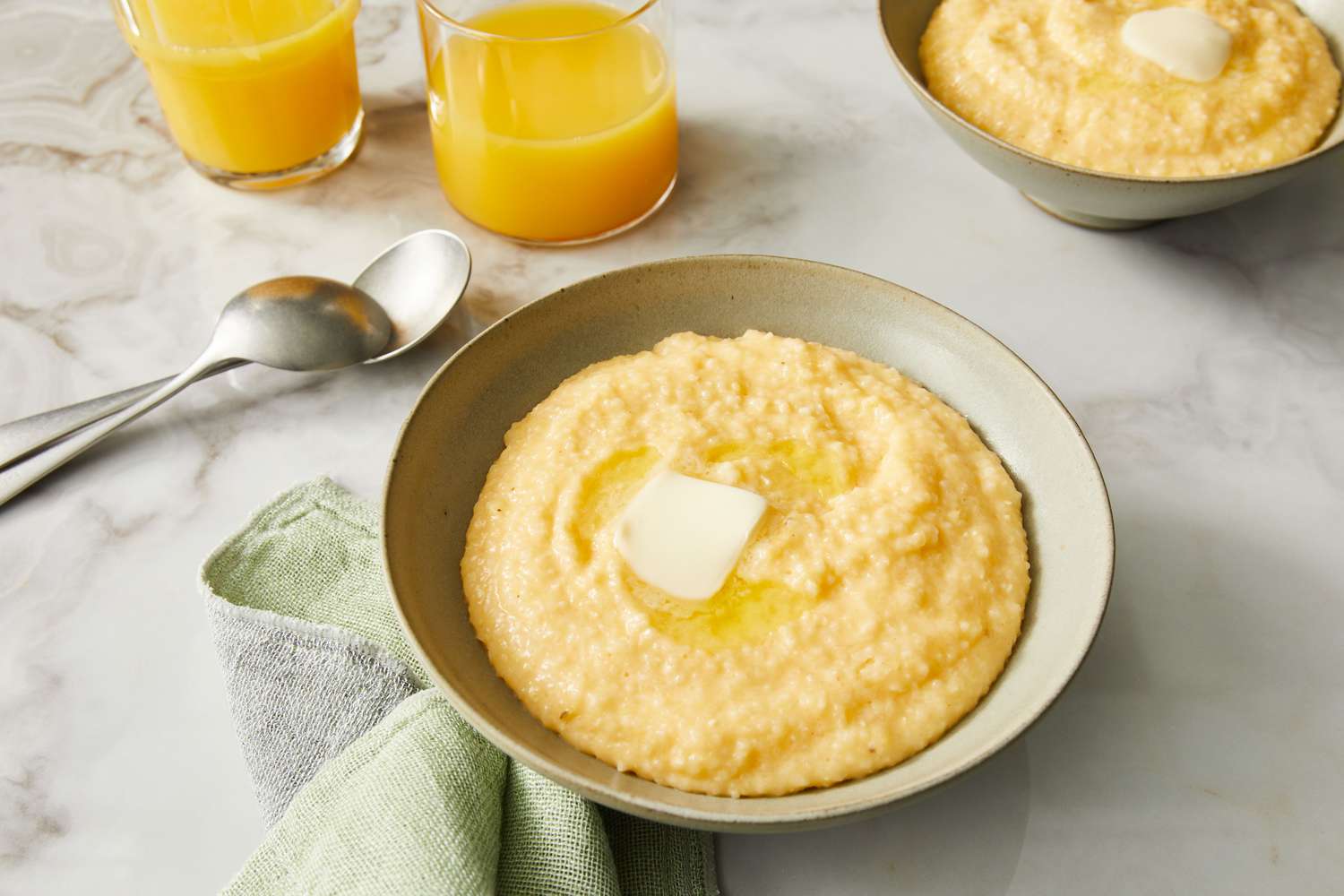
As all good Southerners know, grits are the workhorse of the kitchen. Take almost anything you have in the fridge, stir it into a pot of grits, and you have an instant meal. Creamy, cheesy, sweet, or even baked in the oven, here’s how our Test Kitchen professionals and food editors make their grits perfect every time, whether using the stovetop or an appliance to do the job. Follow these tips and techniques for how to cook grits so they are always perfectly seasoned, smooth, and creamy.
Know Your Types Of Grits
The most important thing is knowing there are different kinds of grits. The ones you find at the supermarket are usually regular grits or quick grits. The difference between the two is just granulation—regular grits have a medium grind and cook in 10 minutes, while quick grits are ground fine and cook in just 5 minutes.
But the best, in our opinion, are stone-ground grits. If you’ve never experienced the fresh corn taste of stone-ground grits, the first intoxicating forkful will make you a believer. They are the kind preferred by purists, produced the old-fashioned way by grinding with a water-turned stone. They have a chunkier texture, retain a more natural and rich flavor, and take about 45 minutes to cook. You can find these at Whole Foods, specialty food shops, and local mills like Anson Mills and McEwen & Sons.
While most grits come in yellow and white varieties, blue grits, made from blue corn, are currently in vogue. They have a higher protein content and are very hard and sweet. Blue grits turn lavender when water is added to the mix, and produce grayish-blue baked goods, like pancakes and cornbread.
Salt Your Water
Cooked grits won’t absorb any more salt, so make sure to salt your water or mix salt straight into the dry grits mix before you start cooking. As a general guideline, the ratio is 1/4 tsp. salt per cup of water, but check the recipe if you’re adding salty ingredients like cheese, ham, or bacon.
Whisk Your Grits Well
Five out of five food editors agree that whisking often (or almost constantly) makes for the creamiest result, since whisking releases starch. Whisking while you slowly pour the grits into the water also helps prevent clumping.
Add Cheese To Your Grits
One of our Test Kitchen professionals says she makes sure her grits have cheese in them every time. But look beyond the classic sharp cheddar. Parmesan and smoked Gouda make for tasty alternatives.
Cook On Low Heat
After bringing the grits to an initial boil, lower the heat to a simmer. Low and slow cooking will result in creamy grits with a soft texture. They release starch as they cook, so give them plenty of time. Grits are not to be rushed. Keeping the lid on a pot of grits traps steam and moisture, and prevents a skin from forming on the surface.
Soak Your Grits
Some Southern cooks swear by soaking stone-ground grits for the creamiest results. It softens their texture and reduces cooking time. To do so, soak the grits in water to cover for a few hours to overnight. Drain the water or use it to cook the grits, according to your recipe. Quick grits do not need to be soaked, but if you do so, soak them for about 30 minutes.
Hold The Cream
Grits absorb water, broth, and milk much better than cream, so if you like yours with whipping cream, just add a touch at the end to smooth out the texture. However, our Test Kitchen recommends a half-water-half-milk, or a half-chicken-broth-half-milk mixture, depending on what type of meal you’re preparing.
Try The Slow Cooker
The slow cooker’s steady, moist heat releases the starch in stone-ground grits with minimal stirring, creating a naturally rich, creamy texture with little or no added dairy products. Here’s the technique for cooking grits in a slow cooker:
- Stir together 1 cup of grits and 3 cups of water in a 3-qt. slow cooker. Let stand for 1 to 2 minutes, allowing grits to settle to the bottom.
- Tilt the slow cooker slightly, and skim off solids using a fine-wire mesh strainer.
- Cover and cook on HIGH for 2 1⁄2 to 3 hours or until grits are creamy and tender, stirring every 45 minutes. Then stir in salt to taste, as well as any cheese, butter, or other ingredients.
Try The Instant Pot
Similarly, cooking grits in an Instant Pot yields quick, creamy grits with no stirring. Here’s how to make grits in an Instant Pot:
- Spray the insert of the Instant Pot with cooking spray to prevent the grits from sticking to the sides and bottom.
- Add 1 cup of grits, 3 cups of water, and 2 teaspoons of kosher salt to the insert and stir to combine, making sure all of the grits are covered in water before cooking.
- Use the manual/pressure cook setting to cook on high for 10 minutes. Once done cooking, let the pressure release naturally and the steam escape.
- Add the remaining ingredients: 1 cup of Parmesan cheese, ½ cup of half-and-half, 2 tablespoons of butter, and any seasonings you desire. Stir until combined.
More Grits Recipes
Whether you’re looking for a scrumptious bowl of Shrimp and Grits or a satisfying helping of Creamy Parmesan Grits, we’ve got you covered. Turn leftovers into grits cakes that you can top with seafood or serve as a side in place of rice or potatoes.
Or add toppings to a bowl of creamy grits. Though we often think of savory dishes like Shrimp and Grits or cheese grits, they are also great with sweet toppings like you would use in your oatmeal, like bananas, peanut butter, jam, honey, berries, maple syrup, nuts, and cinnamon. Savory toppings can include bacon, sausage, peppers, egg, onion, scallions, or herbs.
